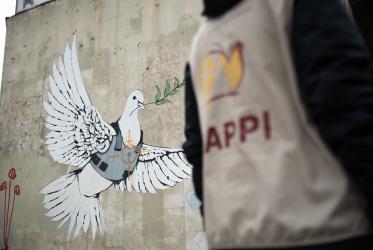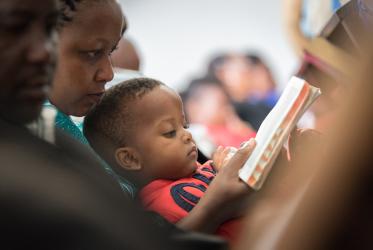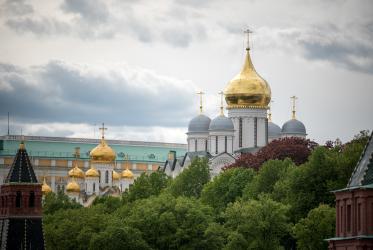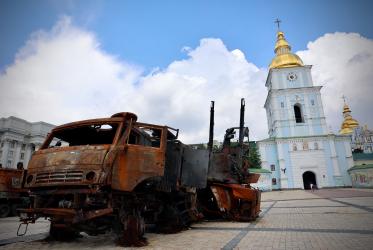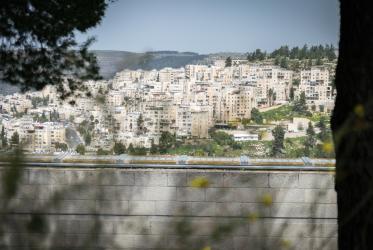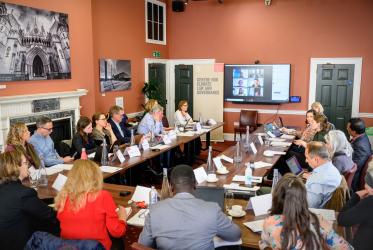In February, during the first three days of the invasion, 6,000 people arrived in Chernivtsi from east of Ukraine, fleeing the war and destruction. “Our monks left their rooms so the refugees can stay there,” said Bishop Kleopa of Novoselytsya, vicar of the Chernivtsi and Bukovyna Eparchy of the Ukrainian Orthodox Church. “And other monasteries in the area have done the same.”
Around 13,000 refugees have been hosted in Banchen since February. Some of them have left for other countries in Europe; some of them plan to return to their homes once it is safe to do so.
But many people who flee do not have means to leave the country, and many also do not have homes anymore.

Children's playground and residential buildings destroyed by shelling in Irpin, Kyiv region.
“People can stay in Banchen while the war lasts,” said Kleopa, adding that many of the refugees have lost their homes twice:—first in the Donetsk or Luhansk region where Russian aggression started in 2014, and more recently in cities like Kherson, which had been their refuge until it was destroyed by invasion in February this year. “We have refugees who are staying with us for three years,” said Kleopa.
The Holy Ascension men’s monastery in Banchen also has its hotel, which now hosts 600-800 refugees, mostly families fleeing the destruction of war from cities like Kharkiv, Kramatorsk, and Kherson.

One of the recently arrived refugees from Donetsk region, Klavdia, has found shelter at the Banchen monastery guest house.
Klavdia is one of the refugees from Kramatorsk in the Donetsk region, she is here in Banchen for three days. She initially arrived in Chernivtsi, a Ukrainian city close to the Romanian border, one of the areas of Ukraine least affected by war. “But it was so difficult to find a flat to rent in a city, the demand due to refugee influx is very high – therefore we are very grateful for the opportunity to stay in Banchen,” said Klavdia.
Banchen monastery also operates the hospital, St Luke's clinic, with 100 beds and 169 employees, run as a private health institution. Hospital services are appreciated by the local community because of the high professionalism of its doctors and accessibility of the modern medical equipment, made possible by the donors of the monastery.

Inside the St Luke's clinic, founded by the The Holy Ascension Banchen monastery.
Since 2002, Banchen monastery runs the orphanage too, currently housing more than 400 children. Among the staff are many nuns of the nearby woman’s monastery. Three months after the Russian invasion they have received 300 orphans from the Donetsk and Luhansk regions of Ukraine.
Among them are 70 children from Kramatorsk. “When bombing started, the whole orphanage of Kramatorsk with children of three months to six years of age, many of them with special needs, along with a few of the personnel and other people who helped on their way through bombings, came here,” said Kleopa. “They were lucky to escape, because a few days later the train station from where they left was bombed,” said Kleopa, referring to the Kramatorsk train station bombing widely reported in the news, when a Russian strike on 8 April killed 59 civilians and wounded more than 110.
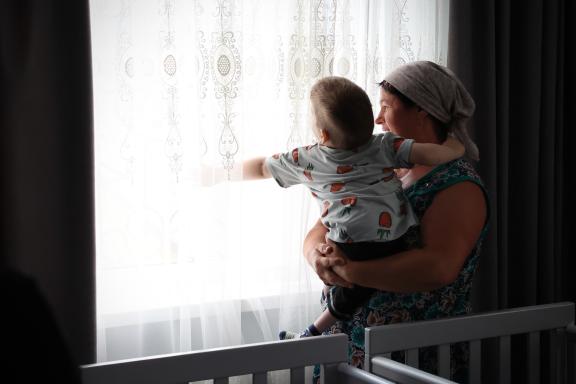
Among the staff of the orphanage at Banchen are people who helped children to flee the war zones, and remained with them when reached safety in Banchen.
The main focus of the orphanage is care for children with disabilities and special needs, including children with AIDS.
With sadness, Kleopa shares that recently a group of children with special needs from the city of Kherson in the occupied part of South Ukraine were not allowed to come to Banchen. “These children were sheltered in a basement, while due to their condition they need a full-time care, special treatment and equipment,” said Kleopa. “We had everything ready – rooms, staff, equipment—we were ready to receive them,” shared Kleopa, when they learned that Russian-controlled occupation authorities of Kherson will not grant permission to the children to leave to the Ukraine side. “We do not know what has happened with them since then”.
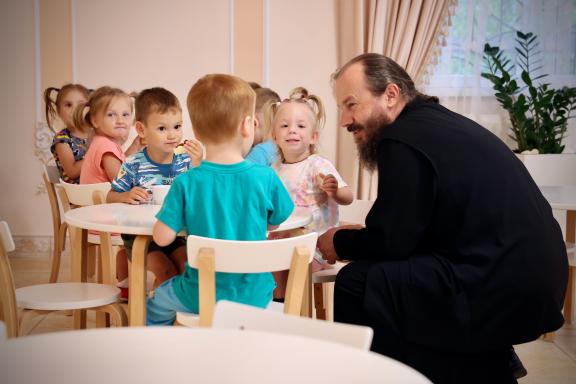
Children at the Banchen orphanage are glad to interact with bishop Kleopa of Novoselytsya, vicar of the Chernivtsi and Bukovyna Eparchy of the Ukrainian Orthodox Church.
Work of the Banchen monastery is just one of the many examples of how churches in Ukraine are helping the victims of war. The Ukrainian Council of Churches and Religious Organizations has repeatedly called on world leaders, international organizations, and church hierarchs to take urgent measures to stop the blockade of cities of Ukraine by the Russian Federation and to organize humanitarian corridors in order to evacuate residents of Ukrainian cities and towns from areas where active hostilities are taking place to safe places of their own choosing.
Photo gallery from the WCC visit at the Banchen monastery
WCC delegation visits Ukraine amidst the ongoing war (WCC news release 6 August 2022)

Interior at the main church of the The Holy Ascension men’s monastery in Banchen, Chernivtsi region, Ukraine.

